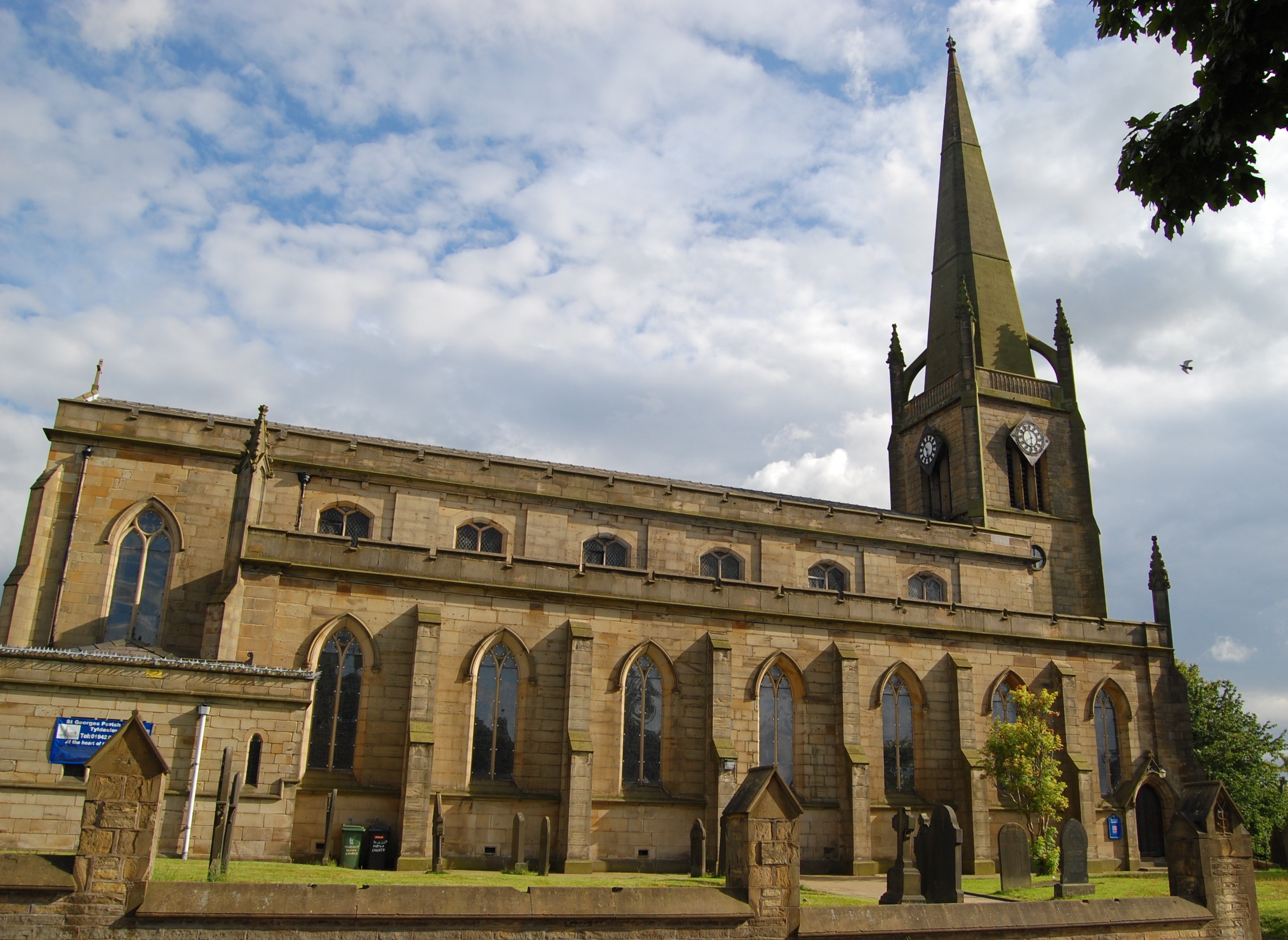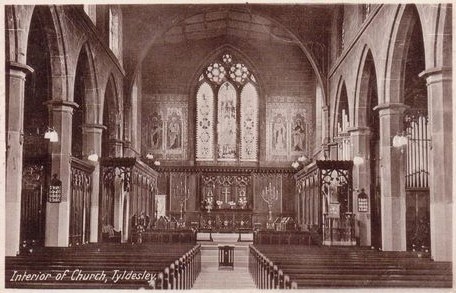St George’s Church is the Anglican parish church serving TyldesleyFormer industrial town in the Metropolitan Borough of Wigan, in Greater Manchester. and Shakerley in Greater Manchester. Together with St Stephen’s in AstleyParish church in Astley, Greater Manchester, built in 1968 after its predecessor was destroyed by arson. and St John’s, Mosley CommonActive church in Mosley Common that was built in 1886. it is part of the United BeneficeCollection of parishes working together under a single incumbent. of Astley, Tyldesley and Mosley Common in the Leigh deanery, the archdeaconry of Salford and diocese of Manchester.[1][2][3]
St George’s was built as a chapel of easeChurch subordinate to a parish church serving an area known as a chapelry, for the convenience of those parishioners who would find it difficult to attend services at the parish church.Church subordinate to a parish church serving an area known as a chapelry, for the convenience of those parishioners who would find it difficult to attend services at the parish church. to St Mary the Virgin’s Church in Leigh. A Waterloo or Commissioners’ Church, it was built in the rapidly expanding townshipDivision of an ecclesiastical parish that had civil functions. in 1825. A mistake with plans led to a larger church being built than the site could accommodate, and extra land and money was donated to ensure it could be completed. The church was extended at the east end and re-seated in the 1880s. St George’s has survived two fires: in 1878 the upper west galley housing the choir and organ was destroyed, and in 1966 a fire destroyed half the roof and part of the ceiling. The churchyard contains the graves of victims of a disaster at Yew Tree CollieryFormer coal mine operating on the Manchester Coalfield after 1845 in Tyldesley, which was then in the historic county of Lancashire, England. Former coal mine operating on the Manchester Coalfield after 1845 in Tyldesley, which was then in the historic county of Lancashire, England. . The church was designated a Grade II listed building in 1966.
History
Until 1789, when the Countess of Huntingdon’s Connexion built Top Chapel, there was no place of worship in the growing township. Tyldesley was part of the ancient ecclesiastical parishAncient or ancient ecclesiastical parishes encompassed groups of villages and hamlets and their adjacent lands, over which a clergyman had jurisdiction. of Leigh that, from medieval times, covered six townships and its population had to travel to St Mary’s in Leigh for baptism, marriage or burial. As the population grew quickly after 1800, a movement seeking to have an established church developed. Thomas Johnson, owner of the Banks Estate, gave a plot of land at the western end of the banks on which to build the church. It was partly paid for by money from the parliament of the United Kingdom raised by the Church Building Act 1818, and said to be a celebration of Britain’s victory in the Battle of Waterloo. The Church Building Commissioners provided £17,000.[4] The architect was Robert Smirke.[5] It was one of 174 neo-Gothic and 40 Classical style churches built under the Act.[6]
Work began in November 1821 and the foundation stone was laid on 23 April 1822 – St George’s Day. As construction progressed, it was realised that the structure was too big for the site and that the plans had been inadvertently exchanged for the Church of St George in Chorley.[7] Johnson’s nephew, George Ormerod gave more land for the churchyard and £2,000 so that the church could be finished. Building work was completed in November 1824. Six bells for the tower were transported on carts from Leigh on 10 August 1825 arriving to celebrations when the largest bell was upturned and filled with ale supplied by all the local inns.[8]
The chapel was consecrated on 19 September 1825 by the Bishop of Chester and dedicated to Saint George.[4] It was licensed as St George’s Chapel, a chapel of easeChurch subordinate to a parish church serving an area known as a chapelry, for the convenience of those parishioners who would find it difficult to attend services at the parish church.Church subordinate to a parish church serving an area known as a chapelry, for the convenience of those parishioners who would find it difficult to attend services at the parish church. of Leigh Parish Church. Tyldesley became a district parish in August 1829. On the last day of 1833, the curate, the Reverend Jacob Robson, writing in the parish registers, signalled the change in spelling of the township’s name from Tildesley to Tyldesley.[9] Fourteen of the twenty-five victims of a firedampDamps is a collective name given to all gases other than air found in coal mines in Great Britain. The chief pollutants are carbon dioxide and methane, known as blackdamp and firedamp respectively. explosion at Yew Tree CollieryFormer coal mine operating on the Manchester Coalfield after 1845 in Tyldesley, which was then in the historic county of Lancashire, England. Former coal mine operating on the Manchester Coalfield after 1845 in Tyldesley, which was then in the historic county of Lancashire, England. in 1858 are buried in the churchyard.[10]
The upper west galley was destroyed by fire in 1878. It housed the choir and organ which were moved to the chancelPart of a church containing the altar, used by the officiating clergy..[11] The church was altered and refurbished in 1886 and 1887 when the east end was extended by 12 feet (4 m) to form a new chancel. At the same time the vestry and entrance porch were added to the north side and the west end of the church was remodelled by architects Preston and Vaughn. The work was completed by contractors Cordingley and Stopford. The large west gallery was removed and a smaller one installed with central doors hung in the archway beneath it. The woodwork was by J. Pearson of Pendleton. The naveCentral part of a church, used by the laiety. and aisle roofs were panelled in pitch pine, the wooden floor was replaced and the windows were reglazed. Paint was removed from the interior stonework and the columns were reduced in thickness. The church was relit and a heating system by John GrundyCompany of heating engineers and ironfounders, started in Tyldesley, Lancashire in 1857. was installed.[12]
In 1920 the the Lady Chapel was dedicated as a War Memorial.[13] A second fire, in 1966, destroyed half the roof and part of the ceiling.[11]
In 1886 St John’s ChurchActive church in Mosley Common that was built in 1886. at Mosley Common was built as a chapel of ease to St George’s.[14]
School
Funds were raised in 1827 and George Ormerod gave a site next to the church for a national schoolSchools set up by Anglican clergy and their local supporters, initially run by single teachers using the monitorial system. that catered for all age groups when it opened in 1829.[15]
Structure
Peel Quarry in Little Hulton supplied the sandstone for the church[16] which is 112 feet (34 m) long and 60 feet (18 m) wide.[17] It was built in the Early English Gothic style[14] with a seven-bay nave and clerestory which, according to Pevsner have, “unconvincing Geometric aisle windows and squashed Y-tracery on the clerestory”.[18] The chancel, added in 1886, has two-light windows to the south and north walls and a three-light east window, all with geometrical tracery. On the north side is a vestry and a porch in the westernmost bay.[5]
The tower at the west end has a west door and rises in three stages to a parapet with crocketed pinnacles and flying buttresses at each corner to a recessed octagonal spire that rises to 150 feet (46 m). At its second stage is a lancet windowTall, narrow window typically associated with the Gothic architectural style., and at the third stage, three lancet belfryStructure in which bells are hung. openings and a clock face to each side of the tower.[5]
Furniture and fittings
The tower contains a peel eight bells, six were cast in 1825 by William Dobson at Downham Market in Norfolk.[17] When the bells were rehung in 1910, two trebles by Mears and Stainbank added.[13] In the 1960s, subsidence and cracks in the tower prevented bell ringing but an inspection in 2012 revealed the bells could be rung again after repairs to the frame. The Lancashire Association of Change Ringers paid for the repairs, and the bells rang out again in December 2012.[19]
The town’s first public clock, with three faces, was installed on the tower in 1847, paid for by public subscription. A four-faced clock installed in 1913, wound by hand until 1967, now has an electrical movement. After 1912 the town council was responsible for the cost of repairs and illumination, and in 1937 electricity superseded gas for lighting its faces.[17]
The church when first built could seat 1,100 people. The church has a west gallery, originally there were two. The original 1825 font was replaced by a larger one in 1853. In 1860 an organ was bought from Willis of London for £350, replacing a barrel organ given by George Ormerod when the church was opened.[20]
Most of the church woodwork dates from the extensions and refurbishment in 1887. The chancel woodwork is in American walnut and was carved by Earp of Manchester. The wooden altar is elaborately carved, as is the reredosLarge ornamented wall, screen, or other structure placed behind the altar in a Christian church.. The pulpit is in carved walnut on a base of Mansfield red stone. A new case was made for the organ at the east end of the south aisle. Pitch pine pews were stained and polished to match the chancel woodwork and replaced the original box pewsType of church seating with enclosed sides..[12][21]
The stained glass in the east window was designed by William Pointer of Manchester and dates from 1956. On either side of the window are mosaic panels dated 1914, each of which depicts two evangelists. The stained-glass windows depicting saints in the north and south walls of the chancel date from the 19th century and were moved from Bishopscourt, the former palace of the Bishops of Manchester, in about 1958. Monuments include one dated 1855 showing a “grieving woman slumped over an urn” and a bronze plaque from 1924.[22]
Clergy
During its first 120 years, St George’s had four incumbents. Jacob Robson came to the church as curate in 1825, becoming vicar in 1842, although Tyldesley was made a parish in 1829. He died in 1851.[9] His successor was George Richards who was vicar from 1851 to 1884, during which time 14 of the 25 victims of the Yew Tree Colliery firedamp explosion in 1858 were buried in the churchyard.[10] John Lund was the next incumbent. He oversaw the extension of the east end of the church in 1886 and the building of the vicarage in 1902.[21] He was vicar for 36 years until 1920, when he was replaced by Samuel Fleming, who was vicar until 1948.[23]




